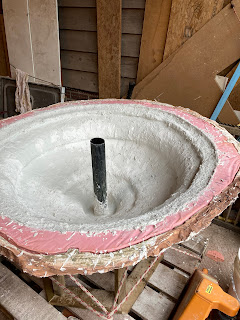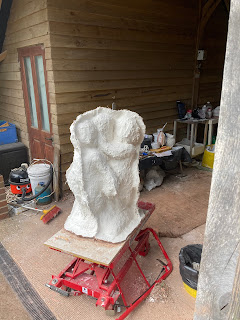Having arrived at the decision to cast a new version in Jesmonite rather than the other options; (a completely new work, a repaired copy in bronze, repair the existing with a composite or do block marble repairs etc.), I decided that key features need to be recorded before it was dismantled, so I used putty rubber to make an impression of faces, hands and feet. See the blue bits in the photo below.
The structure was dismantled and delivered in bits to my studio.
I needed first to remodel the existing marbles without damaging them further.
I used an oil based clay to make four new faces and repairs to the sea dragon’s head and body. All four figures needed body rebuilding including eight feet, eight hands – two of them clasped together, lots of hair and two completely new arms. Here below is the top figure ready for the client’s view.
Then came the tricky bits.
First of all, at a late stage it was decided the old bowl was not fit for purpose and could not be reused because it was damaged and would look very different to the new figures.
Secondly, according to my helpful sources of advice, the use of Jesmonite meant that any mould would have to be especially sophisticated with a minimum of seams as hiding seams in the cast would be extremely difficult.
I learnt a couple of useful tricks, vibration to remove bubbles when mixing Jesmonite and the use of a trowel.
From the above photos you can see it looks quite heavy!
From my research, I was convinced that Jesmonite was the best material to use. It was green, strong and durable. However it seemed that no one had actually done something quite like this before. I knew that just about every garden centre in England had a cast of some 3D figure in a white composite substance which must have been cast from a mould. So a Jesmonite marble would be possible. It had such excellent results aesthetically.
As a sculptor principally in bronze and resin bronze, I have significant experience in doing one piece silicone rubber moulds for the production of 9 casts to fit the ‘Fine Art’ definition of my work. Resin, like Jesmonite is even less tolerant when it comes to seams. It is nigh impossible to hide a seam in resin bronze if it is traditionally paternated.
The top figure, with his interesting Sea Dragon, was relatively easy to mould and cast and needless to say I did him first. The second attempted cast was a success, I learnt a lot from the first and I lost no sleep worrying about it.
The problem on the first cast was caused principally by my inexperienced of Jesmonite but also time; Jesmonite goes hard (cheesy) very quickly indeed. I needed more time, lots more time. This was solved, I got some good advice from Jesmonite themselves. Super Plasticiser, a second additive would keep it more liquid for much longer so helping the pouring process. My supplier had advised one additive Retarder which had given me about 20 minutes to work but Super Plasticiser more than doubled that and the two additives together made it much more liquid and so far easier to work with. Jesmonite also informed me that these additives would improve durability even more.
At this stage my clients, the committee, came to visit to see what I had done so far. Fortunately the top figure with Sea Dragon was looking good and I could demonstrate that Jesmonite shone, sparkling beautifully in the sun. My work on the other figures was progressing well and they left my studio very happy indeed.
My next problem was to mould the bowl. It had been delivered on a pallet and was incredibly heavy. I bought a pallet truck on eBay but the bowl needed lifting so I could place a sealed piece of plywood under it as a base for the mould. A friend and neighbour came to the rescue with his JCB so I was able to construct the mould. Another friend and neighbour made a wooden frame so I could work the cast the other way up.
Casting in progress above; you may remember that March and April 2023 was cold and wet. Jesmonite has to be stored above 5c and wet is not recommended! Tricky unless you are in a controlled environment or factory.
One issue I had been warned about was cracks. When drying and exposed to sunlight others had experienced cracking, presumably splits in the casts later in the process. I am not sure however about this. The only cracks I found were in the jesmonite AC100 which I used for the outer shell of the moulds. They were expected in the nature of shell construction and easily mended. None of the casts however showed any cracks.
My next and final task was even more challenging. A one piece silicone rubber mould of three figures around a central decorative column.
Although I think I knew all the potential things that could go wrong there is always the chance that something would go wrong. In fact it was only the weight of rubber, shell and subsequent cast which proved to be difficult. Like the bowl it was all very heavy and the use of ropes, beams and stack trucks were needed with friends lending a hand that saved the day. My solutions to the problems of weight all look rather ‘Heath Robinson’ in these pictures but they worked.
I needed eight walls and a similar number of plugs. This is were preparation of the original and filling awkward areas of the silicon rubber mould made the whole thing possible. (Next time I will use more keys in the rubber base area).
I was careful to be as accurate in mixing jesmonite as possible. Yes I used a drill to mix the base, liquid, plasticiser and retarder and a drill to vibrate the mixture to remove bubbles before pouring.
You will have spotted in the pictures that some pipe work had to be incorporated into my casts.
Here is the result:
Installed.
Jesmonite is a great material to work with. Yes you can hide seams but keep them to a minimum if you can. Yes you can sand it, fill holes, strengthen it (with chopped strand mat after mixing), and protect it from stains up to a point. However it needs some care and maintenance to keep it looking good. ‘Acid etched’ and it will shine better than marble. All outside Art needs to be maintained, our weather and climate is not kind.
Look after your art and it will love you too.
Source: Dorset Sculpture

























Comments are closed.